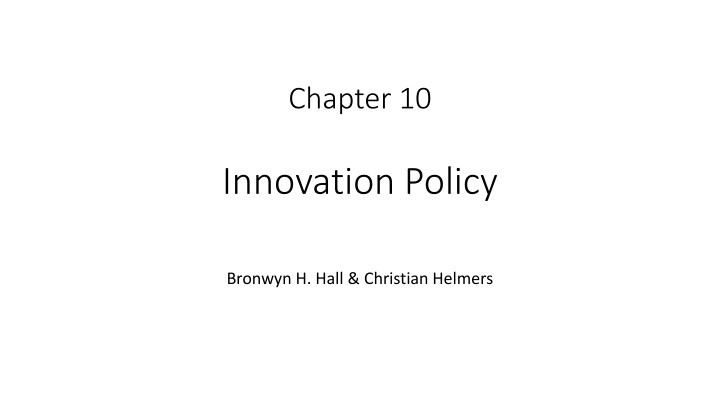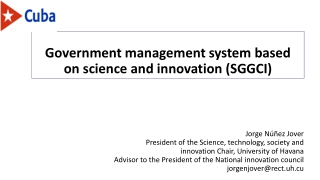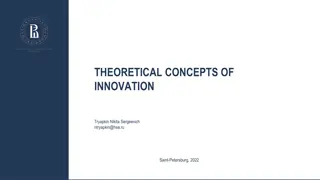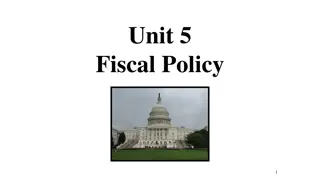Innovation Policy: Motivations and Government Support" (67 characters)
The importance of innovation policies for encouraging innovative activities and the role of government support. Learn about market failure, optimal subsidies, and diverse policy approaches to foster innovation.
Download Presentation

Please find below an Image/Link to download the presentation.
The content on the website is provided AS IS for your information and personal use only. It may not be sold, licensed, or shared on other websites without obtaining consent from the author.If you encounter any issues during the download, it is possible that the publisher has removed the file from their server.
You are allowed to download the files provided on this website for personal or commercial use, subject to the condition that they are used lawfully. All files are the property of their respective owners.
The content on the website is provided AS IS for your information and personal use only. It may not be sold, licensed, or shared on other websites without obtaining consent from the author.
E N D
Presentation Transcript
Chapter 10 Innovation Policy Bronwyn H. Hall & Christian Helmers
Overview Motivations for innovation policy including market failure Determining the optimal government subsidy Range of government policies to encourage innovation IP tax credits and subsidies to promote private R&D spending Direct government support of R&D National Innovation Systems 2024 Hall & Helmers Ch. 10 2
Introduction Role for government policy to encourage and support innovative activities. All countries have some kind of innovation policy, irrespective of the country's political structure and even its development level ( National Innovation Systems ). Diverse set of policies: Education (institutions and students) Direct spending on R&D in e.g. defense and health Tax subsidies for innovative activity in private firms IP system Government standard setting, regulatory standards that encourage innovation (directed towards societal goals e.g. reducing pollution) Economic justification for innovation policy: market failure due to unpriced spillovers and financing constraints faced by innovators. But many other motivations as well. 2024 Hall & Helmers Ch. 10 3
Introduction Central questions when designing policy: Which instrument is effective for which problem? How much to spend on this instrument? Determining optimal policy/subsidy very challenging. 2024 Hall & Helmers Ch. 10 4
Why do governments have innovation policies? Main argument for innovation policy: Social return to R&D and innovation is greater than private return. Private sector will not provide enough innovation on its own. Market failure: Due to unpriced knowledge and network spillovers, market fails to generate appropriate level of innovative activity. 2024 Hall & Helmers Ch. 10 5
Why do governments have innovation policies? Other arguments: More difficult to evaluate and fund some types of research in the private sector (e.g. risk and size of effort is large relative to size of market, but public benefit also large). For some innovations, the benefit is very diffuse and it is difficult to identify those who benefit, making it difficult to collect payment from the users. Strategic industry argument: some industries are very important for national security. Externalities are large but the relevant innovators are small, so it is difficult for them to finance the necessary research and the risk is too great for any individual. Mission-oriented R&D e.g. pollution characterized by double externality problem (positive knowledge spillovers and negative environmental externalities). Policies for range of reasons, not all pure market failures in the economic theory sense, but market fails to deliver right amount of innovation. 2024 Hall & Helmers Ch. 10 6
Government spending allocation for major OECD countries Allocation highly variable across major economies. US very high in defense and health; relatively low education spending at federal level because most of it is state level. Germany, Japan and Korea spend more on industrial technology. 2024 Hall & Helmers Ch. 10 7
Determining the optimal subsidy Innovation policy often involves subsidies or tax incentives directed towards private firms. What's the optimal subsidy? 2024 Hall & Helmers Ch. 10 8
Determining the optimal subsidy What is left out of this simple graph? Magnitude of the spillover gap varies considerably, by country, by industry, and by technology type. Spillovers vary by type of research (fundamental vs. applied science). Project ordering can differ according to whether use social or private returns to rank projects. Not obvious who is better at choosing projects, approaches to a problem, and conducting research: government or private sector. 2024 Hall & Helmers Ch. 10 9
Policy instruments for market failure Standard policy tools for dealing with market failures: 1. Internalize the externality, bring the spillover within the innovating entity so that it has the correct incentives. Essentially hands the social return to the firm. 2. Subsidize the activity if the externality is positive; tax the externality if it is negative. 3. Direct government regulation, mandates for a particular preferred behavior. 2024 Hall & Helmers Ch. 10 10
Internalizing the externality Internalizing the externality: granting ownership of the externality to the entity that is creating it. Traditional example of downstream river pollution from a factory: Grant downstream entity right to clean water and allow to sell the rights to pollute to the upstream factory. Allows downstream entity to choose the level of pollution it finds optimal and to be compensated for it. Downstream entity captures the (negative) social return to pollution. Allows entity maximizing social returns to create deadweight loss (e.g. monopoly). Examples: Property right in the output of the innovative activity (intellectual property). Antitrust exemptions to R&D joint ventures, collaboration in standard setting etc. Solution simply limits spillovers to competitors, but majority of beneficial non-pecuniary spillovers not addressed. 2024 Hall & Helmers Ch. 10 11
Subsidize or tax the activity Direct government subsidy: Social-private returns gap is large and the beneficiaries uncertain and diffuse. Examples: scientific and basic research, higher education, and the health, defense, and space sectors. Tax policy: Spillover gap to be smaller and we use taxes to reduce the marginal cost of industrial R&D. R&D is expensed (same as depreciation rate of 100%). R&D tax credit or super-deduction. Reduced taxes on income generated by IP assets. Returns to foreign R&D can be repatriated to the home country at a low tax rate. Regulation: Often mandate for some kind of efficiency improvement in a product. Example: fuel efficiency standards for automobiles. 2024 Hall & Helmers Ch. 10 12
R&D and IP tax credits and subsidies Encouraging private firms to perform R&D via tax system widespread. Especially popular in high-income economies, 34 of 38 OECD countries have some kind of tax incentive for R&D. Advantages of using tax credits to subsidize R&D rather than directly funding the R&D: Firms choose areas in which to invest, rather than government. Requires less time and management by the government. Less subject to lobbying pressure for specific projects. Allows for firms in a specific area competition among firms with varying approaches to a problem. Disadvantages of using tax credits to subsidize R&D rather than directly funding the R&D: Project choice based on maximizing private returns rather than social. Auditing requirements are expensive for government. 2024 Hall & Helmers Ch. 10 13
Who uses R&D tax credits? 2024 Hall & Helmers Ch. 10 14
Incremental tax credit Incremental tax credit: gives firm a credit only for the amount of R&D spending above and beyond prior spending history. Argument: firm will do some level of R&D without credit, therefore cheaper for government to only give credit on the amount of spending in excess of what firm would have done anyway. 2024 Hall & Helmers Ch. 10 15
Incremental tax credit To compute incremental tax credit, need to determine the level of R&D pre- credit. Creates perverse incentives: past increases reduce credit available in the future, rendering it much less effective (Mansfield, 1986; Eisner et al., 1984). Assume spending eligible for the credit is amount above average of last three years spending on R&D. Marginal tax benefit of a one unit increase in R&D at year t is: ? ?? ? ?? where ? is the tax credit rate, R R&D, B the present discounted value of the tax bill, ? the discount rate. Assume ? = 0.9, effective tax credit is ?(1-(0.9+0.81+0.729)/3) = 0.187 ?. = ? 1 (? + ?2+ ?3) 3 2024 Hall & Helmers Ch. 10 16
IP boxes IP Box: special tax treatment for income attributed to IP. IP covered varies across countries but usually includes patents, utility models, software. 2024 Hall & Helmers Ch. 10 17
IP boxes Motivation: Discourage behavior of multinational firms, who locate ownership of their (highly mobile) intangible assets in low tax jurisdictions and tax havens, in order to pay lower taxes on income earned from those assets. IP box may be a way to subsidize successful innovative activity. Problems: R&D spending directly under control of the firm so the incentive is more immediate. Patent-generated income depends on R&D investment but is influenced by many other factors. Patent boxes target the most directly appropriable part of innovation, patent already represents an incentive. Patent boxes subsidize patent enforcement, since all the income of a patent assertion entity is patent-related income. Patent boxes provide incentive to renew patents that might otherwise be abandoned. Design of patent box difficult as it involves allocation of costs for the non-patent assets that are used in generating the patent income. Government audit costs even higher for the patent box than for R&D tax credit. 2024 Hall & Helmers Ch. 10 18
Government Support for R&D Government funded R&D covers wide range of technologies and its composition varies considerably across countries. Different methods of delivery: Direct spending funded and performed by the government. Spending at government-owned laboratories and research institutions. Spending at private nonprofit laboratories and research institutions. Competitive grants to industry, universities, and research institutions. Examples of successful government-funded innovation: Global Positioning System (GPS) ARPANET/Internet CRISPR 2024 Hall & Helmers Ch. 10 19
Where does government R&D funding go? 2024 Hall & Helmers Ch. 10 20
Composition of US Government spending on R&D, excluding defense Illustrates the emphasis on sending men to the moon in the 1960s-1970s, followed by an enormous increase in spending on health- related research. 2024 Hall & Helmers Ch. 10 21
U.S. Government Support for R&D Fundamental and basic scientific research of all types (National Science Foundation, National Institutes of Health, energy, and space science). Research for military and space applications (National Aeronautics and Space Administration, Department of Defense). Research in applied technology areas perceived to be of national importance in health, energy, and agriculture (e.g., Environmental Protection Agency, Department of Agriculture). Commercialization and adoption programs/ demonstration programs like the clean coal demonstration (Small Business Innovation Research, Advanced Technology Program, Cooperative Research and Development Agreement). Cost-sharing private R&D in commercial areas, e.g., Sematech and the flat panel display project (Advanced Technology Program). 2024 Hall & Helmers Ch. 10 22
Political economy of government R&D The closer government R&D spending is to commercial activities, the more controversial it becomes. Spillover benefits small given the commercial possibilities. Governments bad at picking winners . Politics of government funding: Elected officials care about saliency . Elected officials impatient and risk averse. Asymmetry in the political support for projects. Implication: government spending on short time horizon projects with no radical change in a concentrated industry. 2024 Hall & Helmers Ch. 10 23
Taxes versus subsidies How to choose the optimal mix of innovation policies? How to balance use of tax incentives with use of direct government spending for R&D? Tax incentives leave the choice of R&D and innovation projects to the firm. Government spending more clearly targeted. Balance varies greatly across countries. 2024 Hall & Helmers Ch. 10 24
Taxes versus subsidies 2024 Hall & Helmers Ch. 10 25
Taxes versus subsidies 2024 Hall & Helmers Ch. 10 26
National Innovation Systems A country's innovation policies operate together to form a national innovation system. In most countries not a top-down planned system but rather something that arises from the country's history and culture. E.g., the relative importance of defense R&D in the U.S., or industry-targeted R&D in Korea and Japan. Co-existence of national and regional innovation systems. Benefit of concept: identify complementarities of policies, which can make the system as a whole either more or less than the sum of its parts. 2024 Hall & Helmers Ch. 10 27
Summary Government policy towards R&D and innovation is widespread and takes many forms. Most countries have some form of R&D policy to encourage R&D spending by firms. In almost all countries, some form of education spending. Determining optimal policy mix and level is challenging. Full evaluation of government programs needs a full accounting of benefits, which will include those that are not counted in GDP, such as health and life expectancy. Innovation policy works together with other features of an economy's structure and linkages to create a National Innovation System . 2024 Hall & Helmers Ch. 10 28























